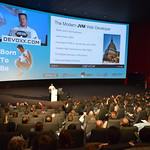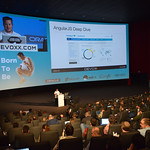 Two weeks ago, Trish and I boarded a flight for one of our favorite conferences: Devoxx. After a brief layover in Frankfurt, we arrived in Amsterdam and took a train to Antwerp. Within hours, we'd settled into our hotel near the center of Antwerp and strolled over to the
dungeonous, yet cozy, Pelgrom restaurant. We were hoping for a delicious
dinner, but found much more. We
ran into James Ward, Dick Wall and a number of other enthusiastic speakers from the conference. Since I had to speak
the next day, we didn't stay long, but we did share a number of laughs with some great people.
Two weeks ago, Trish and I boarded a flight for one of our favorite conferences: Devoxx. After a brief layover in Frankfurt, we arrived in Amsterdam and took a train to Antwerp. Within hours, we'd settled into our hotel near the center of Antwerp and strolled over to the
dungeonous, yet cozy, Pelgrom restaurant. We were hoping for a delicious
dinner, but found much more. We
ran into James Ward, Dick Wall and a number of other enthusiastic speakers from the conference. Since I had to speak
the next day, we didn't stay long, but we did share a number of laughs with some great people.
Tuesday (November 12), was a University Day at Devoxx, and I had my talk that afternoon. I spent a couple hours
finishing up my talk
that morning, then grabbed a taxi to head to the conference. I was honored with the opportunity to speak in Room 8,
which is a huge theater that holds several hundred people.



I presented a lengthened version of The Modern Java Web Developer presentation I did early this year (at Denver's JUG and JavaOne). Based on your feedback, I chose to do deep
dives on AngularJS, Bootstrap and Page Speed. I've always enjoyed speaking at Devoxx because attendees are so
enthusiastic and passionate about the conference. I received an immense amount of feedback, both in praises and
criticisms. The critics indicated there were too many buzzwords and not
enough substance. Others complained that the AngularJS Lipsync that I did was too
deep.
I made sure to review and process everyone's comments, and then used them to improve the presentation throughout the
following week. I learned to elaborate on the fact that many of the technologies were important to know about, but
not important to know through-and-through. I made sure to mention that the use of CoffeeScript and LESS is often
limited (or embraced) by team members and their willingness to try new things. If you're not writing thousands of
lines of JavaScript or CSS, it probably doesn't make sense to use these languages. Furthermore, if your team members
are struggling to write JavaScript or CSS, introducing a new language is probably not the best thing. I also
reminded people to be skeptical of new technology, but also to be open-minded and give everything a chance. The
10-minute, download-and-try test, is a great way to do that.
You can find my presentation below, download it from my
presentations page, or view it on SlideShare.
Within this presentation, there are links to each of the deep dives. The last two are screencasts that I added
audio to a few days ago.
Bootstrap 3 |
AngularJS Deep Dive |
Page Speed Demo
[
Read More]


 This year marked my
This year marked my 




